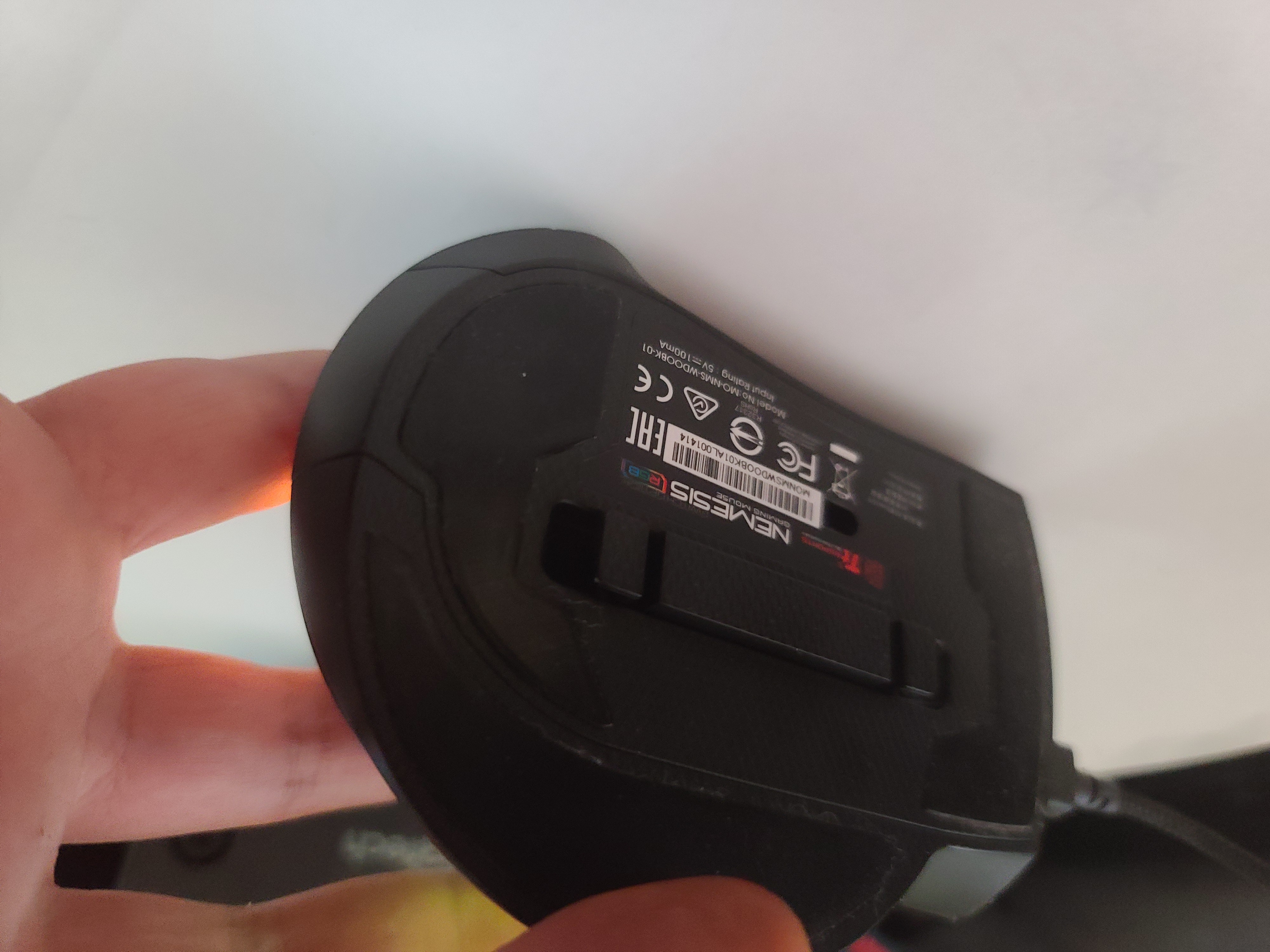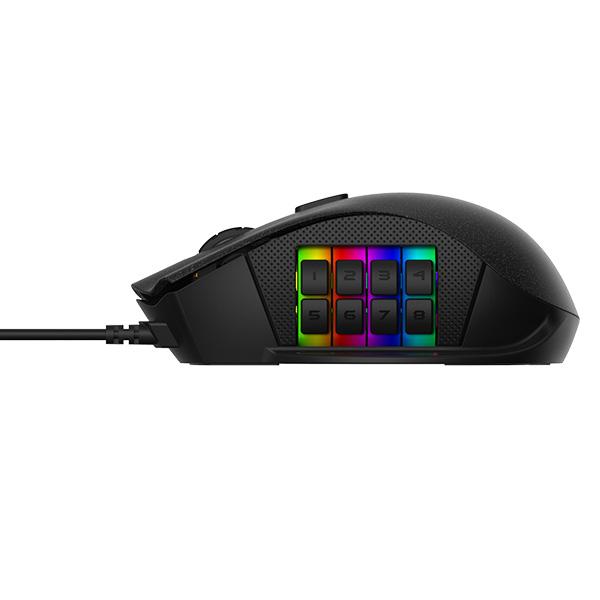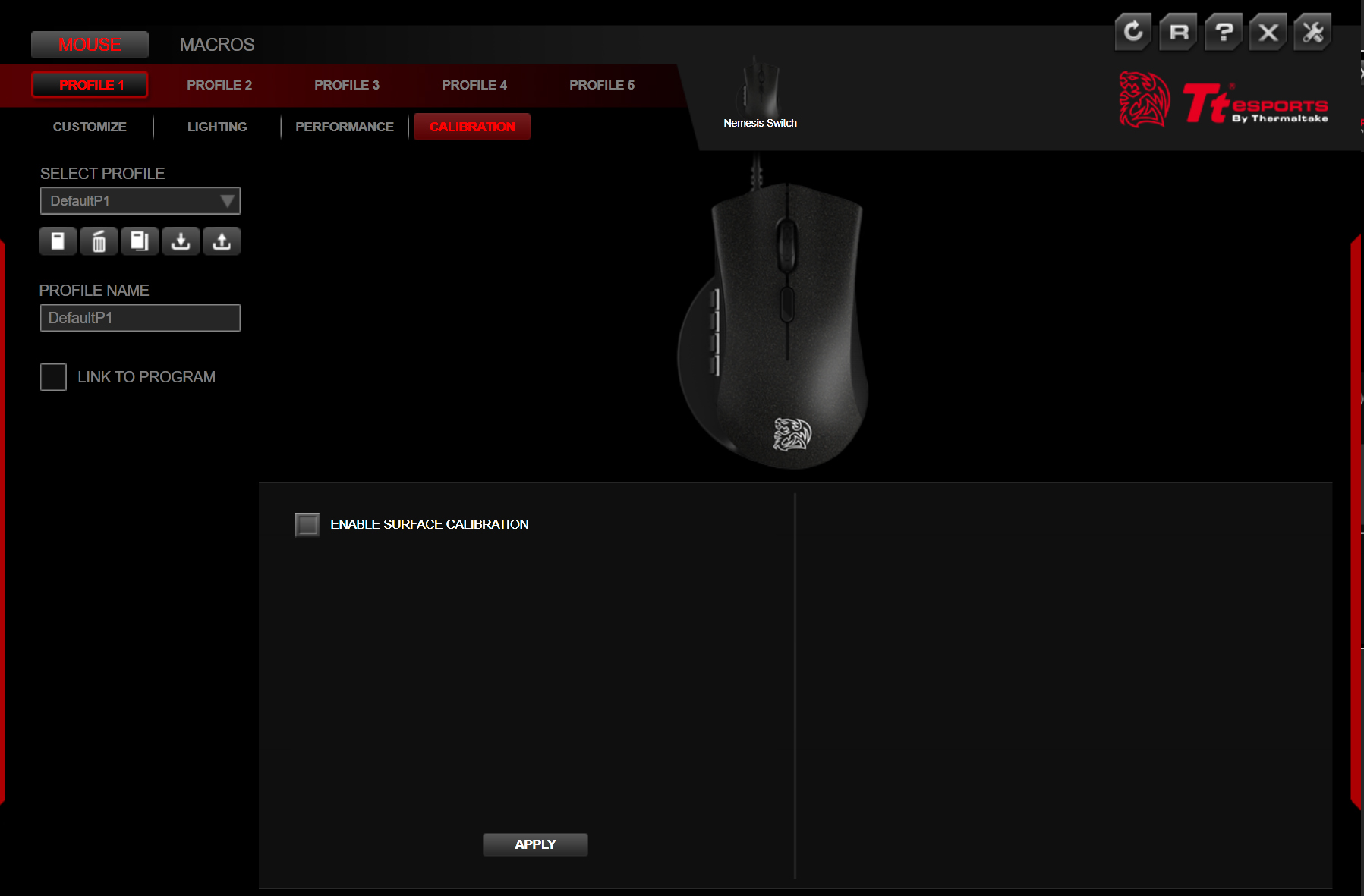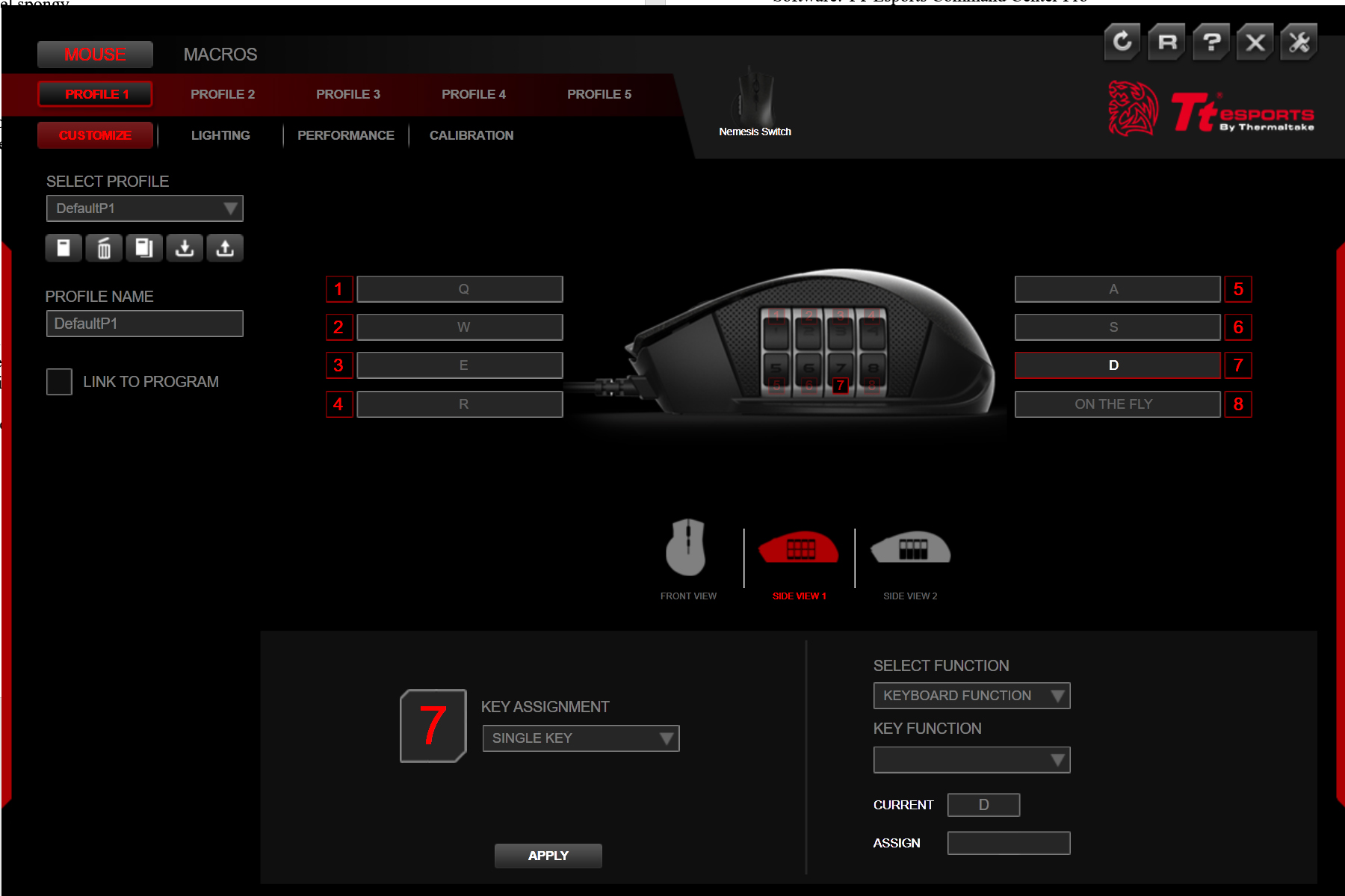Tom's Hardware Verdict
The TT Esports Nemesis Switch is a well-priced quality mouse that attempts to do something different by letting gamers adjust the physical layout of the side macro bank of buttons on the fly. But this ultimately creates more problems than it solves.
Pros
- +
Good price
- +
Accurate sensor
- +
Solid, weighty feel
Cons
- -
Profile switch button is easy to click accidentally
- -
No dedicated CPI switch button
- -
Switchable button layout is impractical and feels unnecessary
- -
Spongy side buttons
Why you can trust Tom's Hardware
It wouldn’t be surprising to come across the Thermaltake TT Esports Nemesis Switch in your search for the best gaming mouse for tackling MOBA / MMO titles. After all, it sports a quality build and a decent price of $50 as of writing.
While Thermaltake’s TT Esports brand succeeded in making a mouse that feels great, the Nemesis Switch’s unique design, which allows you to physically rearrange its 12-button macro bank to make your preferred 8 buttons usable, seems to be a solution to a problem that doesn’t exist. The Nemesis Switch has the fundamentals down, but its key feature makes it stand out from the pack in ways that aren’t all positive.
Thermaltake Tt Esports Nemesis Switch Specs
| Sensor Type | Optical |
|---|---|
| Sensor Model | Pixart PMW3360 |
| Sensitivity | 12,000 CPI |
| Polling Rate | 2,000 Hz |
| Programmable Buttons | 18 |
| LED Zones | 3x RGB |
| Connectivity | USB Type-A |
| Cable | 6 feet (1.8m) |
| Measurements (LxWxH) | 4.37 x 3.48 x 1.53 inches / 111 x 88.5 x 38.9mm |
| Weight | 3.95 ounces / 112g |
Design and Comfort


The Nemesis Switch is an interesting take on the by-now familiar MMO/MOBA mouse design, featuring an array of programmable buttons mounted to the left side of its body. But the Nemesis Switch sets itself apart from similar mice, like the Corsair Scimitar RGB Elite and Logitech G600, by giving users the ability to switch out the button layout on the side panel. To do so, you pull out a release mounted on the bottom of the mouse that allows rotation of the buttons in a manner similar to a combination lock. Once the desired layout is dialed in, the pull-out tab on the bottom of the mouse can be snapped back in to lock the buttons in place. There are 12 programmable buttons in the macro bank, but only 8 max are viewable at a time. Mouse functions are stored after you set the keybinding. This is nice because if you rotate a key out of use, the mouse will still remember the functions when you rotate it back into use later because you’re never really detaching any buttons.
At 4.37 x 3.48 x 1.53 inches and 3.95 ounces, the Nemesis Switch is a large, heavy mouse, but on par with other MMO / MOBA pointers. For comparison, the Razer Naga Trinity is 4.69 x 2.91 x 1.69 inches and 4.23 ounces, and Corsair’s Scimitar is 4.70 x 3.03 x 1.67 inches and 4.30 ounces. The Nemesis Switch has a shape that will be familiar to users of Razer’s Deathadder line, but with the addition of a wide, flat thumb rest on the left side. The thumb rest makes reaching for the side buttons comfortable and easy while also enabling a sure grip.
A profile switching button sits directly under the scroll wheel. That positioning makes it easy to change profiles accidentally, particularly if you’re used to a dedicated CPI selection button being in the same spot.
The primary mouse buttons are mechanical Omron switches that have a satisfyingly tactile feel. The same cannot be said of the side buttons which, while responsive, are not mechanical and feel spongy. Not only do the side buttons lack the snappiness of the primary buttons, they also require significantly more force to actuate. While this did prevent accidental clicks during use, it made actually pressing them on purpose distinctly unsatisfying.
While TT Esports states that the Nemesis Switch is ideal for all grip types, we feel that the mouse has a bit too much height and all around girthiness to comfortably facilitate a claw style grip. If you get a Nemesis Switch, you’ll be better off employing a palm grip for maximum comfort.
Get Tom's Hardware's best news and in-depth reviews, straight to your inbox.
Gaming Performance


The Nemesis Switch is designed for MMO/MOBA games, so I spent a lot of time with DOTA 2 while this mouse was in my possession. Assigning abilities and items to the side buttons made for noticeably more efficient play, and the weighty feel was just right. For those accustomed to heavier mice, the Nemesis Switch will feel great. But if your preference lies with lightweight pointers, long sessions with this mouse could cause fatigue.
While the ‘on-the-fly’ button layout switching capability of the Nemesis Switch is certainly novel, it didn’t really come into the picture during gameplay, as there’s not enough time to make such changes mid-game. Instead, this feature is more useful if you want to set up different layouts for different games.
Ultimately, I’d rather have all 12 buttons of the macro bank accessible at all times instead of the ability to adjust it to position 8 to my liking. Sometimes, more is more. Corsair’s Scimitar, Logitech’s G600 and Razer’s Naga Trinity all have banks with 12 buttons that are always usable. Tt Esports could have also provided a 12-button bank and offered more functionality, even if it wasn’t adjustable.
But that’s not even my major issue with the Nemesis Switch. No, that honor goes to the lack of a CPI button. You could set a different CPI to each profile and then toggle profiles via the button south of the scroll wheel. However, that’s cumbersome to set up, as you have to manually assign every keybinding for each profile. You could speed up the process of making these adjustments by exporting your first profile and then importing it into the other profile slots, making only CPI changes needed. But that’s still a complicated workaround.
Another option is to enable CPI adjustments on the fly is to sacrifice one of the side buttons. But in games like Dota 2 that rely on an eight button layout, this is a significant problem. The mouse’s left, right and scroll wheel buttons are also programmable.
The lack of a dedicated CPI button also makes the Nemesis Switch less versatile. First-person shooter (FPS) titles load players up with varying weapons options where use of a dedicated sensitivity adjustment button is much more important than it is in MOBAs or MMOs. When I brought the Nemesis Switch over to an FPS battlefield, I liked programming every weapon to a key in the macro bank. But without a dedicated CPI button on the mouse for twitching, I had to move away from my gaming keyboard’s WASD keys or use the scroll wheel for weapon hunting, which I find inefficient.
Again, this could’ve been addressed with different CPI settings per profile and using the profile switch button, but that’s complicated, as mentioned. Notably, the profile switching button, located directly under the scroll wheel, can be very easy to mis-click.
Users have the option to bump the Nemesis Switch’s Polling rate up to 2,000 Hz from the standard 1000hz, but doing so didn’t noticeably improve how the mouse performed during my testing. The Nemesis Switch’s Pixart PMW3360 sensor is very accurate and tracked well, even during lift off. Whether playing DOTA 2, Doom Eternal or CS:GO, the optical sensor proved reliable, although the mouse’s design certainly favors MOBAs and MMOs over FPS titles.
Features and Software




The Nemesis Switch is complimented by the free TT Esports Command Center Pro. In many cases, installing software with peripherals can be considered optional. But if you want to get full functionality out of the Nemesis Switch, this one should be considered mandatory. Without the software, the bank of buttons on the side will default to their numeric key values, and you won’t be able to adjust sensitivity on the fly (there’s no default button for this function). Thankfully, installation is painless and doesn’t even require restarting your gaming PC.
You can save up to five profiles with the software. The app is easy to navigate, featuring two tabs located at the top dedicated to mouse customization and recording macros. Under the mouse tab, you can customize key bindings and lighting effects, as well as make performance adjustments and surface calibrate the mouse. All parameters are very easy to adjust, and the interface is uncluttered.
Thermaltake gets high marks for software that is lightweight, clean and simple to use. But it’s a pity that the software is required to unlock some basic functionality found in most gaming mice.
Bottom Line
The Thermaltake TT Esports Nemesis Switch is solid and comfortable. Its sensor is very accurate and responsive. And simple, intuitive software makes customizing key bindings and performance parameters a breeze.
That said, the shortcomings of its adjustable macro bank design put it behind some competitors. The Logitech G600 is available for the same price as our review subject and has a dedicated CPI switch button and larger macro bank. The Corsair Scimitar RGB Elite is pricier ($80 as of writing) but also comes with a 12-button bank and a wide CPI range. Ultimately, the Nemesis Switch’s design feels like it gets in the way because there are numerous workarounds required to do something you can do with other MMO mice out of the box, like be able to adjust pointer sensitivity and switching profiles without needing to dig through menus, move buttons or sacrifice macro slots. In the case of the Razer Naga Trinity ($74), you can simply snap in a different layout when desired, instead of twisting a bike lock-like aparatus around until you're happy with it.
Additionally, the lack of a dedicated CPI switching button is frustrating. The competitors above include this.
However, the Thermaltake TT Esports Nemesis Switch does come at a competitive price and is easy to program to your liking -- once you get used to its unique design.
MORE: Best Gaming Mice
MORE: Gaming Mice Reviews
MORE: Best RGB Mouse Pads

Nate Rand is a freelance reviewer for Tom's Hardware US, covering gaming headsets, keyboards, mice, and microphones.